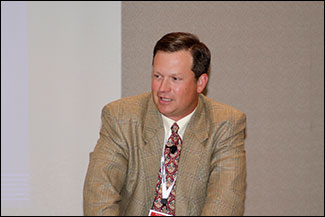Don’t Blame the Bull
Should we rethink contemporary groups, sorting at or before conception?
by Kasey Brown, associate editor, Angus Journal®
LINCOLN, Neb. (June 19, 2014) — With the recognition of potential developmental programming and epigenetic effects, Dan Moser, associate professor in beef cattle genetics at Kansas State University, proposed the idea of redefining contemporary groups to attendees of the joint meetings of the Advancements in Selection Decisions and Advancements in Producer Applications committees. These committees were breakout sessions of the 2014 Beef Improvement Federation (BIF) annual meeting and research symposium in Lincoln, Neb., June 18-21.

Dan Moser, associate professor in beef cattle genetics at Kansas State University.
He explained that traditional methods of genetic evaluation consider the animal through genetic effects; the environment through contemporary groups; unexplained variation through residual effects; and genetic and environmental variance, which are components of heritability.
However, Moser asked, if other effects impact the calf before birth, how does that change the comparisons?
Developmental programming is the phenomenon that management during pregnancy affects the calf. Epigenetics is the phenomenon that progeny show modified gene expression when the dam is subjected to severe stresses during pregnancy. This isn’t a change in the DNA, he clarified, but it does change the regulation of gene expression. This means the modified gene expression doesn’t show up on a SNP chip. Some of these potential stressors include forage availability and quality, higher milk production during early pregnancy, late weaning, and a mismatch of genetics and environment.
Can we successfully model developmental programming? He suggested a few options to consider. One option is expanding the definition of contemporary group by extending it to include common management from weaning of the previous calf. Another is grouping first-calf heifers in their own contemporary groups. The developmental programming effects might be partially accounted for with age-of-dam adjustments on a breed-wide basis.
Nevertheless, these options would reduce contemporary group size. For a long time, Moser noted, the industry has preached larger contemporary groups because you lose information with smaller groups. This poses the question of how much do we gain with more effects accounted for but in smaller groups? He did grant that loss of contemporary group size can be partially offset with genomic evaluation.
To model epigenetic effects, Moser suggested grouping progeny data by the dam’s birth year. For example, this would group the cows that were born in a severe drought together and observe their calves together. Producers who retain females to older ages would see greater division of groups.
He doesn’t recommend changing the model overnight, especially with additional concerns. Most likely, heifer calves from malnourished dams would be less likely to enter the herd, lessening the overall impact of these effects. However, such effects may be more prevalent with embryo transfer and cooperator herds. So far, the effects of developmental programming and epigenetics appear small; and the stucture of contemporary groups limits our ability to model the effects. Field data research with detailed management information is needed to clarify the significance of the effects, he concluded.
The 2014 BIF Annual Meeting & Research Symposium was hosted by the University of Nebraska–Lincoln, the U.S. Meat Animal Research Center and the Nebraska Cattlemen June 18-21 in Lincoln, Neb. The Angus Journal and LiveAuctions.tv provide comprehensive online coverage of the event at www.BIFconference.com. Visit the Newsroom for summaries, proceedings, PowerPoints and audio of the sessions; the Awards page for announcements of award winners; and the Photos page for galleries of photos from the meeting and the tours.
Editor’s Note: This summary was written under contract or by staff of the Angus Journal.Through an agreement with the Beef Improvement Federation, we are encouraging reprinting of the articles to those who will adhere to the reprint guidelines available on this site. Please review those guidelines or contact Shauna Rose Hermel, editor, at 816-383-5270. PowerPoints are posted with permission of the presenter and may not be reproduced in whole or in part without the express permission of the presenter.
API's coverage of the event is made possible through collaboration with BIF and sponsorship of LiveAuctions.tv. For questions about this site, or to notify us of broken links, click here.
Headquartered in Saint Joseph, Mo., API publishes the Angus Journal, the Angus Beef Bulletin, the Angus Beef Bulletin EXTRA, and the Angus Journal Daily, as well as providing online coverage of events and topics pertinent to cattlemen through the Angus Journal Virtual Library.



